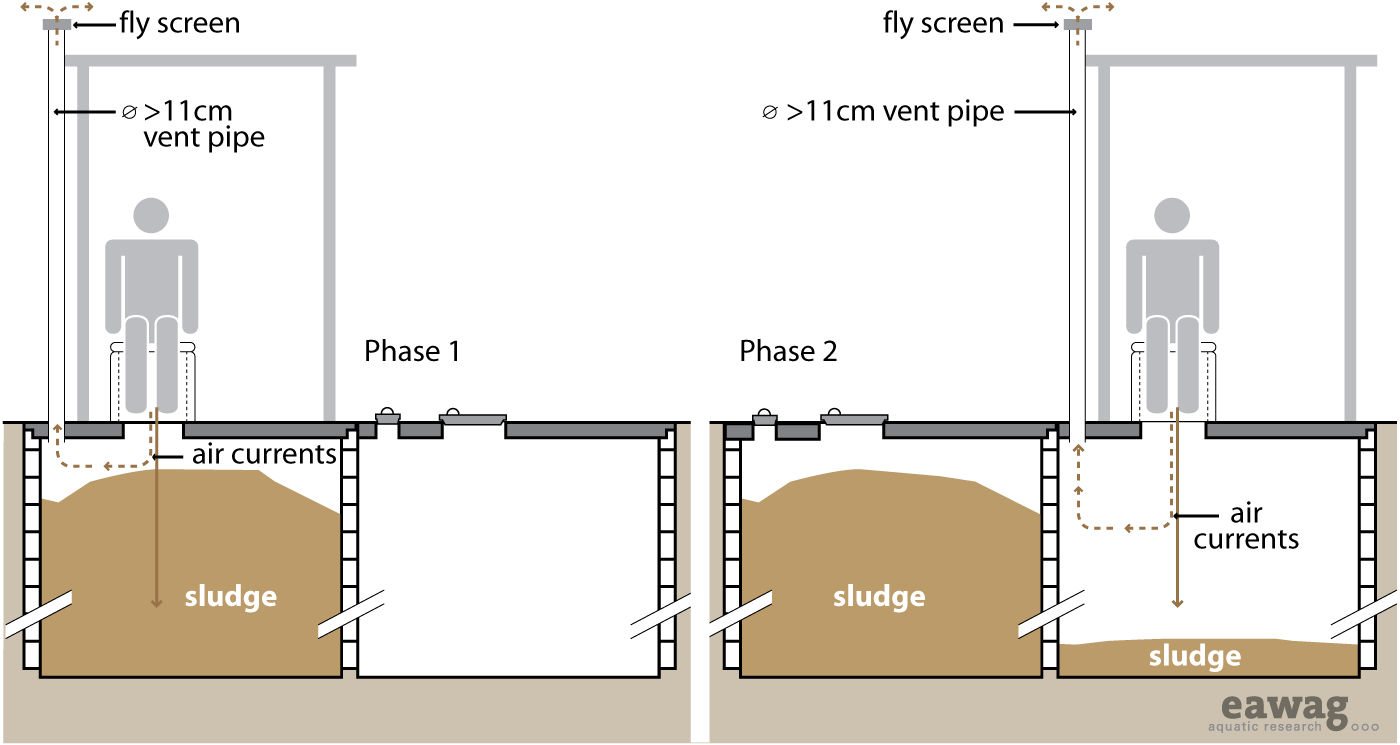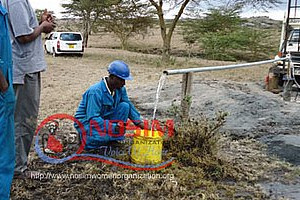Double Ventilated Improved Pit
|
|
|||||||||||||||||||||||||||
The Double VIP (S.4) has almost the same design as the Single VIP (S.3) with the added advantage of a second pit that allows the technology to be used continuously and allows for safer and easier emptying.
By using two pits, one pit can be used while the contents of the second pit rests, drains, reduces in volume, and degrades. When the second pit is almost full (the excreta is 50cm from the top of the pit), it is covered, and the contents of the first pit are removed. Due to the extended resting time (at least 1 year of filling/resting) the material within the pit should be sanitized and humus-like. The Double VIP is similar to the Fossa Alterna technology with the exception that the Fossa Alterna is specifically designed to produce humus and as such, it requires regular additions of soil, ash and/or leaves.
Design Considerations: The superstructure may either extend over both holes or it may be designed to move from one pit to the other. In either case, the pit that is not being filled should be fully covered and sealed to prevent water, garbage and animals, or people from falling into the pit. The ventilation of the two pits can be accomplished using one ventilation pipe moved back and forth between the pits, or each pit can be equipped with its own dedicated pipe. The two pits in the double VIP are continually used and should be well lined and supported to ensure longevity.
| Advantages | Disadvantages/limitations |
|---|---|
| - Longer life than Single VIP (indefinite if maintained). - Excavation of humus is easier than faecal sludge. - Significant reduction in pathogens - Potential for use of stored faecal material as soil conditioner. - Flies and odours are significantly reduced (compared to non-ventilated pits). - Can be built and repaired with locally available materials - Does not require a constant source of water. - Suitable for all types of user (sitters, squatters, washers and wipers). - Can be used immediately after construction. - Small land area required. |
- Manual removal of humus is required - Possible contamination of groundwater - Higher capital cost than Single VIP; reduced operating costs if self-emptied. |
Contents
Appropriateness
The Double VIP is more appropriate than the Single VIP for denser, peri-urban areas. After the resting time, the soil-like material is manually emptied (it is dug out, not pumped out), so vacuum truck access to the pits is not necessary. The double VIP technology will only work properly if the two pits are used sequentially and not concurrently. Therefore, an adequate cover for the out of service pit is required. Double VIPs are especially appropriate when water is scarce and where there is a low groundwater table. They should be located in an area with a good breeze to allow for proper ventilation. They are not suited for rocky or compacted soils (that are difficult to dig) or for areas that flood frequently.
Health Aspects/Acceptance
The Double VIP can be a very clean, comfortable and well accepted sanitation option, in some cases even more so than a water-based technology. However some health concerns exist:
- Latrine leachate can contaminate groundwater;
- Pits are susceptible to failure/overflowing during floods; and
- Health risks from flies are not completely removed by ventilation.
Operation & Maintenance
To keep the Double VIP free of flies and odours, regular cleaning and maintenance is required. Dead flies, spider webs, dust and other debris should be removed from the ventilation screen to ensure a good flow of air. The out of service pit should be well sealed to reduce water infiltration and a proper alternating schedule must be maintained.
Field experiences
References
- ARGOSS (2001). Guidelines for Assessing the Risk to Groundwater from on-Site Sanitation. British Geological Survey Commissioned Report, CR/01/142, Keyworth, UK.
- Franceys, R., Pickford, J. and Reed, R. (1992). A Guide to the Development of on-Site Sanitation. WHO, Geneva, CH.
- Graham, J. P. and Polizzotto, M. L. (2013). Pit Latrines and Their Impacts on Groundwater Quality: A Systematic Review. Environmental Health Perspectives, National Institute of Environmental Health Sciences, Research Triangle Park, US.
- Mara, D. D. (1984). The Design of Ventilated Improved Pit Latrines. UNDP Interregional Project INT/81/047, The World Bank and UNDP, Washington, D.C., US. (A good reference for detailed double VIP design information)
- Mara, D. D. (1996). Low-Cost Urban Sanitation. Wiley, Chichester, UK. (Book; General description of VIPs with a focus on the ventilation system)
- Morgan, P. R. (2009). Ecological Toilets. Start Simple and Upgrade from Arborloo to VIP. Stockholm Environment Institute, Stockholm, SE.
Acknowledgements
The material on this page was adapted from:
Elizabeth Tilley, Lukas Ulrich, Christoph Lüthi, Philippe Reymond and Christian Zurbrügg (2014). Compendium of Sanitation Systems and Technologies, published by Sandec, the Department of Water and Sanitation in Developing Countries of Eawag, the Swiss Federal Institute of Aquatic Science and Technology, Dübendorf, Switzerland.
The 2nd edition publication is available in English. French and Spanish are yet to come.



